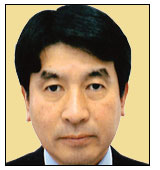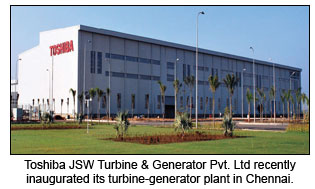 — Yoshiaki Inayama, Managing Director,
Toshiba JSW Turbine & Generator Pvt Ltd
— Yoshiaki Inayama, Managing Director,
Toshiba JSW Turbine & Generator Pvt Ltd
Toshiba JSW Turbine & Generator Pvt Ltd represents the coming
together of the Toshiba Group of Japan and the Indian steel major
JSW Group. The joint venture recently opened its new
manufacturing facility for manufacture of high efficiency steam
turbines and generators for power plants. In an exclusive
interaction,
Yoshiaki Inayama, discusses the supercritical power
equipment market in India, and also how the new JV promises to
bring to India Toshiba's technical expertise and reliability. An
interview by
Venugopal Pillai.
Given that India is most likely to continue its reliance on coalfired
power plants, how do you see the market for supercritical
power equipment in India?
More than 80 per cent of the power plants planned in the XII
five-year plan are thermal, and among them 60 per cent are
supercritical thermal power plants. Moreover, almost all the
power plants in the XIII five year plan will be planned based on
supercritical technology. In order to keep the momentum of
rapid economic and industrial growth of India, continuous
capacity addition in power sector is imminent. The government
has realized the same and has aggressive capacity addition
plans in the tune of 15,000 mw per year for the next decade or
so. Toshiba Group, with its strong local presence, sees a very
good business avenue in India.
Tell us about the total investment made so far by the two
partners (Toshiba and JSW) in the joint venture. What would be
the fund infusion in the coming years?
The total amount of investment is about Rs.800 crore so far by
both the partners in the JV. We have planned to increase the
manufacturing capacity from 3,000 mw to 6000 mw in FY15.
What would be the general lead time for a 800-mw TG set, and
when is the first TG set likely to be shipped from the new
Chennai plant?
The manufacturing lead time ex-works basis for a 800-mw
turbine is around 18-22 months. We have already started the
manufacturing and supplying of major TG components to the
export market. Manufacturing of supercritical turbine involves
precision machining of heavy components, developing and
training such skill sets and most importantly developing a
reliable and sustainable vendor base in India. We are steadily
and systematically approaching the above steps and we expect
to deliver the complete turbine shipped from the Chennai Plant
by end of 2013.
The Indian manufacturing sector is widely believed to be facing
problems in creating an efficient supply chain. What is your
view and how does Toshiba-JSW plan to address this issue?
For the survival and competitiveness we should source as much
as possible from the local industry, and complete technology
transfer from Toshiba. For more than two years now, Toshiba's
specialists from Japan are visiting the local manufacturers and
helping them to develop the products and to put systems in
place to match the quality standards of Toshiba, Japan. I am
sure we will succeed in our goal of creating a reliable supply
chain in India.
What was the rationale behind selecting Tamil Nadu as the
site? Tell us about the strategic advantages and also about the
local employment opportunities that the modern plant would
create.
The Tamil Nadu Government was very forthcoming (in terms of
land allocation and providing all necessary clearances (lease of
state government land, infrastructure building, tax disposal))
when Toshiba JSW showed its intention to manufacture power
plant equipment in India. Chennai being a major port
destination in South Asia, the location has strategic
advantages to cater to the export markets. Hence it helps to
transport these heavy equipments via sea route. Since Chennai
in the fourth biggest city in India, it is excellent also in request
of staff adoption. Toshiba JSW is expected to have a direct
employment of about 500 people by 2014.
 What is your view on the domestic availability of key material
like special steel that would go into the making of supercritical
turbine-generators? Would you also be importing certain
varieties of steel?
What is your view on the domestic availability of key material
like special steel that would go into the making of supercritical
turbine-generators? Would you also be importing certain
varieties of steel?
To the extent of possible, we are sourcing raw materials
from India. There are certain heavy forgings and castings
required for manufacturing of supercritical turbines and
generators. Toshiba JSW is working closely with the
manufacturers of these products in developing them as a
reliable vendor base in India.
Going forward, do you see the Chennai plant exporting to other
developing economies?
Yes, the Chennai plant will also cater to the export market in
the future.
India is considering imposing an import duty of 19 per cent on
power plant equipment with a view of curbing imports from
China. What is your reaction?
It will definitely be a welcome move, as it creates a level
playing field and protects the interest of the domestic
manufacturers who have made serious investments in the
country.
What is your overall view on the penetration of Chinese
equipment (BTG sets) in the Indian power sector?
In the supercritical equipment market, Chinese equipments
have market share among the customers, who are looking
for low-cost machines. Most of the plants are not yet
operational and the performance of these low-cost machines
will be known only after a few years of operation. On the
other hand, Japanese and European equipments have
hundreds of successfully running supercritical plants
across the world. Please note that the supercritical plants
being put in India are for serving the base load requirement,
that means the reliability and availability of the equipment is
very important.
With more domestic players in the market today and price
levels becoming competitive we expect to see a change in the
buying pattern of Indian power project developers.
Please elaborate on the recent orders for supercritical power
equipment received by Toshiba Group in India. (eg Meja, Kadgi,
etc). How does the order pipeline look?
Yes, Toshiba JSW secured the orders for Meja 2x660-mw TG
island package and Kudgi 3x800-mw TG island package as part of the bulk tendering by NTPC. There was stiff competition
among the domestic manufacturers and this order booking
shows Toshiba JSW competitiveness in the market. We
received the above orders because of the performance
guarantee excellence when compared to our competitors.
A large number of domestic companies are entering the power
plant equipment market through joint ventures. What is your
take on the impending competition?
Fair competition is good for the industry and brings out the best
for the customer. The Indian power market has potential for all
the players in the market provided some of the regulatory
bottlenecks, availability of coal and projects come up as
planned in the next two five year plans.
Please discuss how Toshiba Group through this joint venture
and other entities aims to become a complete solutions
provider to India's power generation sector.
Toshiba Group has established a network of companies
that provides localized one-stop EPC solutions, from
plant conceptualization to commissioning. Toshiba India
Private Limited in Gurgaon undertakes overall project
management and plant engineering; TPSC India in Hyderabad
carries out installation and commissioning; and Toshiba JSW,
the jewel in the crown, manufactures steam turbines and
generators.
What are the key milestones that you would like to see the
Toshiba-JSW joint venture achieving in its first five years?
Toshiba equipment is known for its technical expertise and
reliability. We are looking for seamless technology transfer
from Toshiba Japan over a period of time and attain 100 per
cent indigenization with the same quality standards as that of
Toshiba Japan. So what customers will get is Japanese quality
at Indian price!